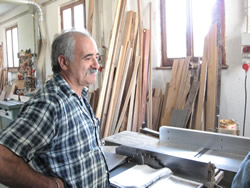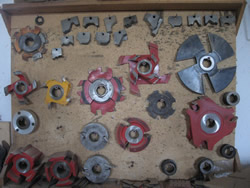by Kimberly Schurtz
In Gian Carlo Renga's garage workshop, the smell of freshly sanded wood emanates from oak panels lined up like soldiers by the doorway. Renga reaches for one of the panels and slides it through the buzz saw, cutting it into two uniform pieces. Once the wood passes through Renga examines each piece closely and sands both from top to bottom before putting them aside to rest. He then gets a panel that has already been cut, pulls out his tape measure and makes three evenly spaced marks on the wood. He carries the oak panel with his rough hands over to his workbench and drills holes into the center of each of the marks he has just made. Renga continues this pattern until he has all of the pieces of wood cut and then begins to nail them together.
The room refl ects Renga's enthusiasm. It is clear that every piece of furniture he makes and every two-by-four he sands is done with real zeal. ects Renga's enthusiasm. It is clear that every piece of furniture he makes and every two-by-four he sands is done with real zeal.
"If I could go back and do it all over again, I would do this because I love it so much. It is my passion," Renga said.
When Renga began to learn his craft, he thought he wanted to work with marble and stone, but he soon changed his focus to wood design because he loves working with wood and seeing the transformation from planks into furniture. He got his vocational diploma in Cagli, and his love for the area has kept him in the town.
Renga, who has been in the furniture business for over 35 years, and spent the first five working in a factory to learn more about the trade and gain experience. For the past 30 years, he has been working in Aquaviva, a nearby town, in the garage sho p of his house. p of his house.
"Since I have always worked in this area, I belong here. My family is from here. This is where my roots are. I could never leave," Renga said.
There is no store where customers can buy his products. Prospective clients can come to the shop to order any of his pieces of furniture. Renga does not think that advertising his business is necessary. People find out about his business by word of mouth.
A year ago, Renga created his own Web site, where clients can review items he has made before they place an order. Since then, there has been a demand for his furniture from people all over Italy, including Pisa, Milan and Rome. But he was forced to turn them down because he already has so much work to do for people in the area.
The bulk of  the time that he spends cutting, sanding and nailing the wood in his workshop is for furniture pieces that the Cagliesi use in their homes: a large pine table and chairs to seat eight, coffee tables, cabinets and countertops. The furniture segment of Renga's business is more popular than the other pieces that he makes, which include window frames and doors. Luckily, he prefers to make furniture. He feels that any carpenter can make something simple, but only a true craftsman can give a house life through the furniture. the time that he spends cutting, sanding and nailing the wood in his workshop is for furniture pieces that the Cagliesi use in their homes: a large pine table and chairs to seat eight, coffee tables, cabinets and countertops. The furniture segment of Renga's business is more popular than the other pieces that he makes, which include window frames and doors. Luckily, he prefers to make furniture. He feels that any carpenter can make something simple, but only a true craftsman can give a house life through the furniture.
"Not many people do this kind of detail work," said Renga. "If they wanted something without inspiration, then people would go to a regular store."
Renga does not usually look for models to imitate. He may see somethi ng and elaborate on it, but "a true artist's work comes from within." Crafting wood into pieces of home decor and home art is not just a career for him but is also his hobby. He works 12 hours almost every day because he enjoys what he does. Sometimes he will redo a chair or a dresser all over because he was not happy with the outcome of the piece. Renga is a perfectionist who refuses to sell something that has any sort of mistake or is not top quality. ng and elaborate on it, but "a true artist's work comes from within." Crafting wood into pieces of home decor and home art is not just a career for him but is also his hobby. He works 12 hours almost every day because he enjoys what he does. Sometimes he will redo a chair or a dresser all over because he was not happy with the outcome of the piece. Renga is a perfectionist who refuses to sell something that has any sort of mistake or is not top quality.
The government in Italy protects the oak trees in the various regions, so it is hard to find good oak. As Renga explained, oak is also harder to work with than a wood like pine because of the density, thus increasing the price of the furniture that is made with it. Renga said he believes that local elm is good to use, but he prefers not to use elm from other countries because it lacks the quality and strength of the elm in Italy. |
